
An Incomplete Guide to Inclusive Language for Startups and Tech

Former Director of People @ Buffer
Language is one of the most powerful tools we have as humans. It binds us. Instructs us. When used well, it creates a common understanding.
And it’s essential for creating an environment where everyone feels welcome and included.
Historically, language has left many out. Individuals and groups have been marginalized and discriminated against because of their culture, race and ethnicity, gender, sexual orientation, age, disability, socioeconomic status, appearance and more.
We can do better. Inclusive language seeks to treat all people with respect, dignity, and impartiality. It is constructed to bring everyone into the group and exclude no one.
It does ask something of us. It asks us to try. To change deeply embedded habits. To consider the implications of words and phrases that have long gone unchallenged. To dig deep into empathy and imagine an experience not our own.
Some of these language changes might seem unnecessary or even silly to some. And even if you were to follow every recommendation here, you might still offend someone or say the wrong thing.
A person can spend a long time on this journey to a more inclusive way of communicating and still make many mistakes. But why not try? Nothing is lost in the process, but so much is gained.
As my teammate, Niel shared with me, “Communication is not what you say, but how it’s heard.” Making changes to use more inclusive language offers us a chance to grow and become better communicators while also caring for those we’re communicating with. “It’s been incredibly helpful for me to move away from ‘Oh that’s not what I meant, I meant it in this way, you’re reading too much into it’ straight to ‘You’re right. I apologize for not understanding what that word meant to you. I’m going to work on this and try to be better,’ “ Niel shared.
If that spirit of self-improvement resonates with you, perhaps this inclusive language guide for startups/tech will help. And if you can think of any words, phrases or examples we didn’t cover here, please share in the comments!
6 overall inclusive language principles
It’s not always necessary to fret over every word. A few big principles can take you quite far. Here a 6 that many folks involved with diversity and inclusion recommend.
- Person-first vs. identity-first language: Person/people-first language tends to be the preferred option for describing individuals and groups of people with a shared identity/identities, centering the individual as the most essential element, e.g., "a person with a disability" instead of "a disabled person". Identity-first language puts the descriptor first, and is more common among specific communities, such as the deaf community, where “deaf person” is generally preferred over “person with deafness". Ultimately, different groups have different preferences, and people within groups have different preferences. When in doubt, it's best to ask.
- Avoid idioms, jargons, and acronyms: Jargon and acronyms can exclude people who may not have specialized knowledge of a particular subject and impede effective communication as a result. Many idioms don’t translate well from country to country, and some are rooted in negative connotations and stereotypes (“hold down the fort,” “call a spade a spade” are examples).
- When speaking about disability, avoid phrases that suggest victimhood, e.g. “afflicted by,” “victim of,” “suffers from,” “confined to a wheelchair”. While you’re at it, steer clear of euphemisms like “challenged,” “differently abled,” or “specially-abled,” too.
- Don’t underplay the impact of mental disabilities. Terms like “bipolar,” “OCD” and “ADD” are descriptors of real psychiatric disabilities that people actually possess. They are not metaphors for everyday behaviors. Also, avoid derogatory terms that stem from the context of mental health, for example, “crazy,” “mad,“ “schizo,” or “psycho.”
- “Guys” is not gender neutral. “The ”universal male” (i.e., using “guys” to mean “people”) assumes that the normal, default human being is male. “Although “he” and “man” are said to be neutral, numerous studies show that these words cause people specifically to think of males.
- If you aren’t sure, ask. Strive to include language that reflects peoples’ choice and style in how they talk about themselves.
37 key phrases for talking about diversity and inclusion in tech
Our quest to be as inclusive as possible means that quite a few new vocabulary words might pop up from time to time as we learn from each other. Here are some words that can offer a greater entry point into the inclusion conversation.
Ableism: Practices and dominant attitudes in society that assume there is an ideal body and mind that is better than all others.
Accessibility: The practice of designing and developing web sites and web content that provide a great experience for all web users. (Sometimes abbreviated as a11y, representing “accessibility” as “a” followed by 11 more letters, followed by “y”.)

ADA: The Americans with Disabilities Act (ADA) is a U.S. civil rights law that prohibits discrimination against individuals with disabilities in all areas of public life, including jobs, schools, transportation, and all places that are open to the general public.
Ageism: A system of beliefs, attitudes, and actions that stereotype and discriminate against individuals or groups on the basis of their age.
Ally: Someone who supports a group other than their own (in terms of racial identity, gender, faith identity, sexual orientation, etc.) Allies acknowledge disadvantage and oppression of other groups; take risks and action on the behalf of others; and invest in strengthening their own knowledge and awareness of oppression.
Affinity groups: A group of people who choose to meet to explore a shared identity such as race, gender, age, religion, and sexual orientation. These groups can be further broken down into smaller groups within the two major affinities (i.e. White men, White women, African American men/women, bi/multi-racial, etc.). At work these are are sometimes called Employee Resource Groups, or ERGs.
Amplification: A technique an ally can use to boost the message of a member of a less dominant group by repeating what that person said and giving them credit for it. For example, “Laura said to try ‘git rebase -i master’. Give that a try and let her know how it works.”
Cisgender: Individuals whose gender identity and expression line up with their birth-assigned sex.
Code of conduct: A set of rules issued by an organization outlining the acceptable and unacceptable behavior of a community or conference. It must have four complete parts:
- statement of unacceptable behavior
- how the policy will be enforced
- how and whom to make an incident report to
- training and reference materials for organizers, staff, and volunteers on how to respond to incident reports
Example: http://confcodeofconduct.com/
Code switching: The practice of mixing various languages and speech patterns in conversation –or more broadly, changing the way you express yourself culturally and linguistically based on different parts of your identity and how they are represented in the group you’re with.
Culture fit: The likelihood that a job candidate will be able to conform and adapt to the core values and collective behaviors that make up an organization. (Alternatives we prefer at Buffer: cultural contribution, values fit)

Diversity: Individual differences (ability, learning styles, and life experiences) and group/social differences (race/ethnicity, class, gender, sexual orientation, country of origin, as well as cultural, political, religious, or other affiliations) that can be engaged in the service of learning.
Dominant culture: The cultural beliefs, values, and traditions that are centered and dominant in society’s structures and practices. Dominant cultural practices are thought of as “normal” and, therefore, preferred and right. As a result, diverse ways of life are often devalued, marginalized, and associated with low cultural capital. Conversely, in a multicultural society, various cultures are celebrated and respected equally.
Equal Employment Opportunity: (EEO) Title VII of the U.S. Civil Rights Act of 1964 that prohibits discrimination in any aspect of employment based on an individual’s race, color, religion, sex, or national origin.
FMLA: The Family and Medical Leave Act of 1993 (FMLA) is a United States federal law requiring covered employers to provide employees with job-protected and unpaid leave for qualified medical and family reasons.
Gender identity: A person’s perception of their gender, which may or may not correspond with their birth sex.

HBCU: An acronym that stands for “historically black colleges and universities.” These are institutions of higher education in the United States that were established with the intention of primarily serving the black community, though they have always allowed admission to students of all races. Most were created in the aftermath of the American Civil War.
Implicit bias: The attitudes or stereotypes that affect our understanding, actions, and decisions in an unconscious manner. These biases are activated involuntarily and without an individual’s awareness or intentional control.
Impostor syndrome: A phenomenon in which high-achieving individuals are unable to internalize their accomplishments and instead constantly fear being exposed as a “fraud.” Some research indicates that members of underrepresented groups are more likely to be affected by it than others.
Inclusion: A dynamic state of operating in which diversity is leveraged to create a fair, healthy, and high-performing organization or community. An inclusive environment ensures equitable access to resources and opportunities for all. It also enables individuals and groups to feel safe, respected, engaged, motivated, and valued, for who they are and for their contributions toward organizational and societal goals.
Inclusive design: The process of making your product intuitive, accessible to, and usable by as many people as reasonably possible without the need for special adaptation or specialized design
Inclusive development: The process of ensuring that all marginalized and excluded groups are stakeholders in development processes.
Intersectionality: The interconnected nature of social categorizations such as race, class, and gender that can create overlapping and interdependent systems of discrimination or disadvantage. The term was coined by Kimberlé Crenshaw, who used it to describe the experiences of black women – who experience both sexism and racism.
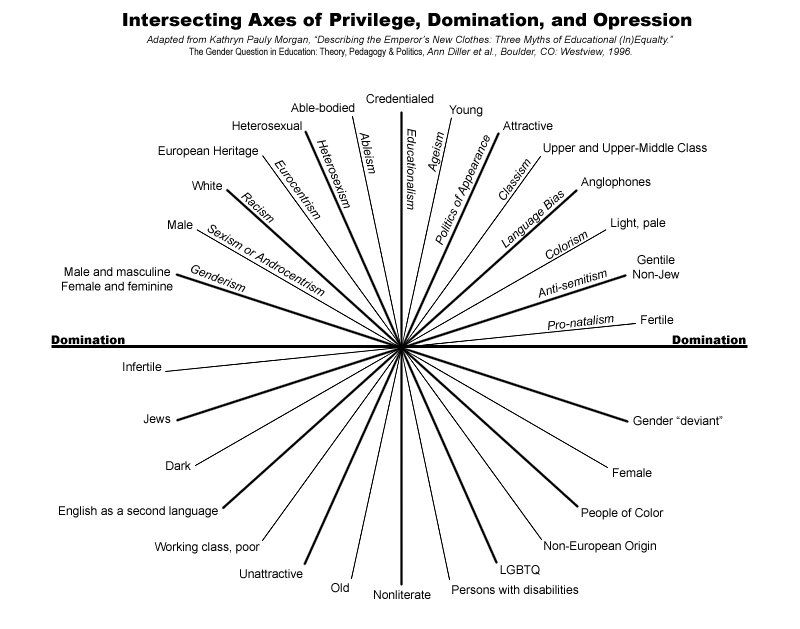
Latinx: A gender neutral term often used in lieu of the gendered “Latino” or “Latina” when referring to individuals with cultural ties to Latin America and individuals of Latin American descent.
LGBTQIA: Acronym encompassing the diverse groups of lesbian, gay, bisexual, transgender, transsexual, queer, intersex and asexual populations and allies/alliances/associations.
Mansplain: A portmanteau of the word “man” and “explain” used to describe the act of men explaining to someone, typically a woman, in a manner regarded as condescending or patronizing.
Microaggression: This term was coined by psychiatrist and Harvard University professor Chester M. Pierce in 1970 to describe the tiny, casual, almost imperceptible insults and degradation often felt by any marginalized group.
Neurodiversity: The idea that neurological differences like autism and ADHD are the result of normal, natural variation in the human genome.
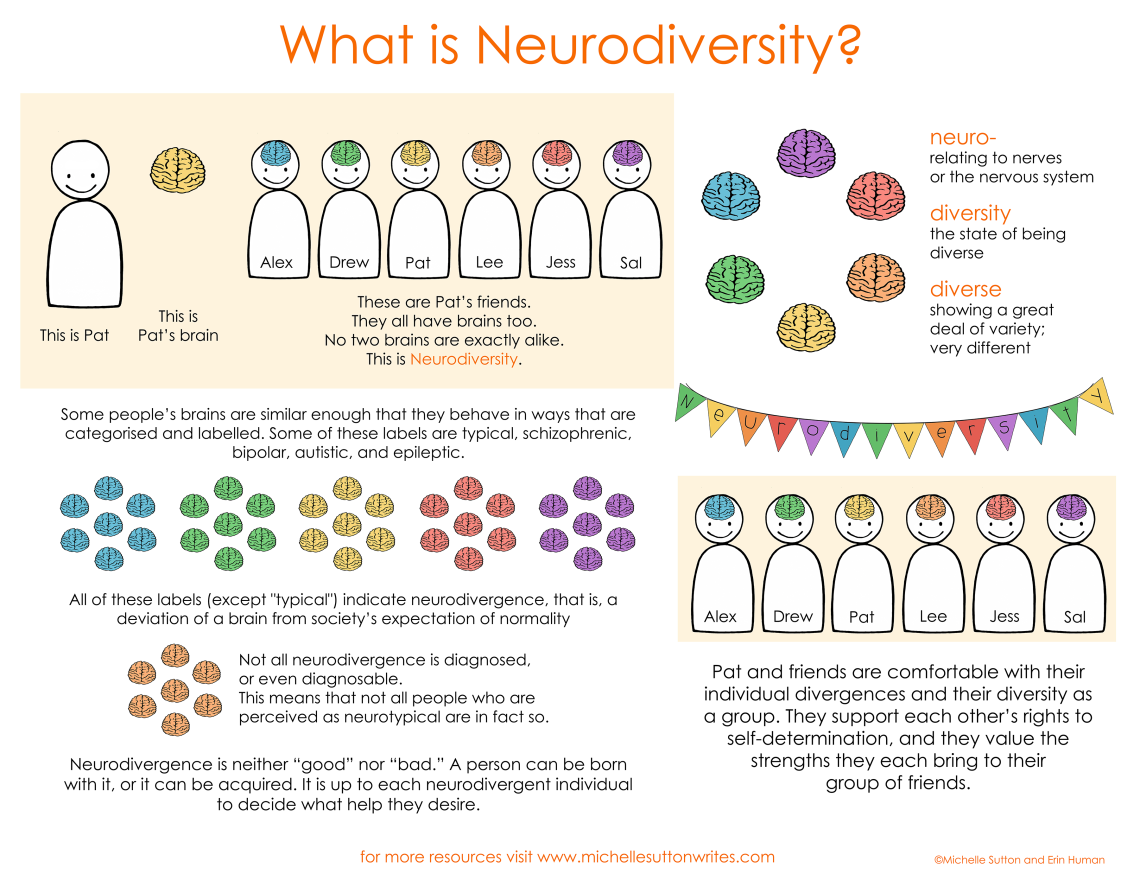
Nonbinary: Any gender identity that does not fit the male and female binary.
Pipeline problem: The belief that the tech industry isn’t diverse because of a scarcity of available talent. The reality is that the pipeline is only part of the issue – better recruitment tactics and interview processes, a focus on retention and lots more can help create more diversity.
POC: An acronym standing for “person of color.” This term is used primarily in the United States to describe any person who is not white (although racism affects different groups differently).
Privilege: A right or advantage that only some people have access or availability to because of their social group membership. (Here’s a well-known exploration of white privilege.)
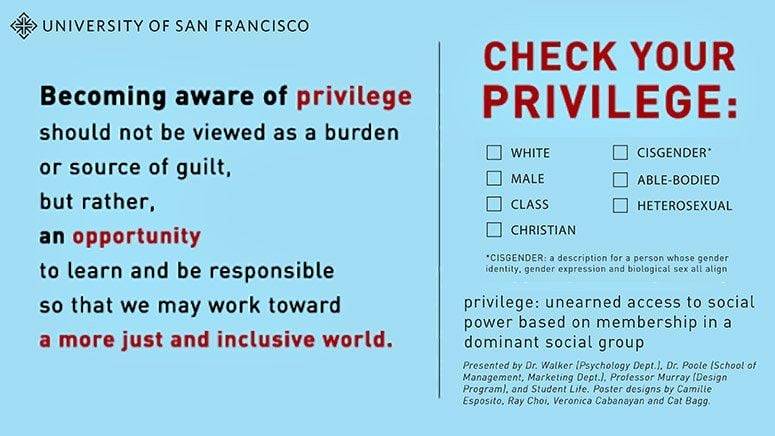
Pronouns: Maybe you’ve seen a Twitter bio with a line that says “My pronouns are…” A preferred gender pronoun is a consciously chosen set of pronouns that allow a person to accurately represent their gender identity. A trans person may begin using a gender-neutral pronoun prior to transitioning, or a non-binary person may choose to use a neutral pronoun.
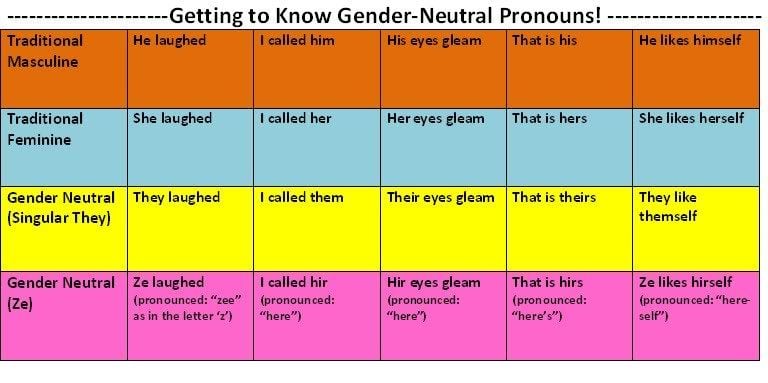
Sponsorship: An action that allies and those with privilege can take to advance the careers of members of marginalized groups. While mentors offer advice and support as needed, sponsors use their social capital and credibility to advocate for their protégés by promoting, protecting, preparing, and pushing them.
Tokenism: The practice of including one or a few members of an underrepresented group in a team or company, without their having authority or power equal to that of other group members. This places a burden on an individual to represent all others like them. (Example: When the lone person in an underrepresented group is consistently asked to speak about being a member of that group.)
Tone policing: Tone policing is a silencing tactic used in arguments or discussions that focuses on the emotion behind a message rather than the message itself. (for example, telling someone who is discussing an issue that makes them upset to “calm down” instead of responding to their concerns).
Underrepresented group/underindexed group: This terms describes any subset of a population that holds a smaller percentage within a significant subgroup than it holds in the general population. Women are often an underrepresented group in science, technology, engineering, and mathematics, for example.
18 phrases it might be better to avoid
As language evolves and our understanding and empathy increases, it’s often a good practice to dive deeper into specific word choice. Some of these words and phrases are benign, while many carry a fraught history or connotation. In all cases, there’s likely a better and more specific option (we’ve tried to provide alternatives!)
- Girl/Girls: For anyone over 18 years old, woman or women is a better choice.
- Grandfathering/grandfather clause: A way to exempt some people from a change because of conditions that existed before the change (e.g. we’ve grandfathered some users on an unlimited data plan.”) The term “grandfather clause” originated in the American South in the 1890s as a way to defy the 15th Amendment and prevent black Americans from voting. A good alternative might be “legacy”
- Guys: When referring to mixed-gender groups. Alternatives: people, folks, teammates
- Gypped: Racial slur for being defrauded, swindled or cheated. According to the Oxford English Dictionary, the term is “probably an abbreviation of ‘gypsy,’ a word commonly used to describe the Romani people.
- Females: To many English speakers, “females” sounds like a scientific designation one would use for animals or plants. Try “women” instead.
- Hacker: In job descriptions, the term ”hacker” can be tough for many to identify with. Hackbright Academy, an engineering fellowship for women, works with many organizations to revisit their job listings in order to paint a clearer picture of what it’s like working there. Alternatives: engineer, developer
- Handicap: Some disability advocates believe this term is rooted in a correlation between a disabled individual and a beggar, “who had to beg with a cap in his or her hand because of the inability to maintain employment.” Better alternative: Disabled
- Housekeeping: In reference to office work, this language can feel gendered. Suggested alternative: maintenance, cleanup
- Ladies/gals: Terms like “ladies”, “gals” or others can feel patronizing to some. Try women instead, or “folks” or “people” for mixed-gender groups.
- Lame: Originally used in reference to people with reduced mobility, now often a synonym for “uncool.” Both types of uses are ableist.
- “Lower the bar:” A phrase based on the erroneous idea that a company has to relax hiring standards in order to add people from different racial/ethnic/gender backgrounds. In fact, in many cases it’s the opposite: companies have a poorly designed hiring bar that fails to adequately evaluate highly qualified, and often diverse, candidates.
- Man: As a synonym for work – as in “man hours,” “man the inbox,” “man the conference booth,” – this is unnecessarily gendered language. Try using work instead.
- Master/slave: Problematic term sometimes used to refer to one machine that has the original copy of data and others that automatically update themselves to match its data. Replacements include primary/replica, primary/standby.
- Meritocracy: Belief in the flawed idea that hard work and talent alone are all that’s needed to achieve success. Challenges like implicit bias, structural inequality and varying degrees of privilege or disadvantage mean meritocracy isn’t currently a reality.
- Mom test/girlfriend test: A sexist term for putting a product in front of unfamiliar visitors to learn more how they would use it. The assumption that if such a person can use a program, anyone can, is both sexist and ageist. Alternatives: user testing
- Ninja/rockstar: Words sometimes used in tech job descriptions that can skew towards a gendered interpretation and discourage some groups from applying.
- Open the kimono: Problematic business jargon for disclosing information about the workings of a company. It has sexist and racist overtones.
- Peanut gallery: This term for heckling or unwanted disturbance originates in the 1920s when the peanut gallery referred to the back section of theaters, which were the only places that people of color were allowed to sit at the time. The phrase was meant to poke fun at the idea of people of color engaging in intellectualism.
Plus 8 quick language substitutions
Some habits are hard to break! If you’re anything like us, you’ve tried to change a language pattern and fallen back into old habits at least a few times. Here are some quick language substitutions for common situations that might help:
More inclusive: Folks, people, you all, y’all, teammates
Less inclusive: Guys (or women) when referring to people overall
More inclusive: Women
Less inclusive: Girls (when referring to adults)
More inclusive: Workforce, personnel, workers, team
Less inclusive: Manpower, man hours
More inclusive: Chairperson, chair, moderator, discussion leader
Less inclusive: Chairman, foreman
More inclusive: Spouses/partners
Less inclusive: Wives, husbands, boyfriends, girlfriends
More inclusive: Parenting
Less inclusive: mothering, fathering
More inclusive: Typical
Less inclusive: Normal
(There’s bias inherent in using one group as a standard against which others are judged. Use of the word normal as a comparison group can stigmatize people who are different and imply they are abnormal.)
More inclusive: Marginalized groups or underrepresented groups
Less inclusive: Minorities
(Not all marginalized groups are minorities, and a broader term is generally inclusive of more than race and gender)
A special note on the generic “he” in tech
Particularly in tech conversations and job descriptions, sometimes the pronoun “he” is used to describe technical roles or executive roles by default. Here’s an example from an old job listing at Buffer:
“We’re looking for a person who embodies this community spirit and is excited to share his knowledge with the broader web development world.”
Assuming that the normal, default tech person is a man has real consequences. In one survey on what deters women from male-dominated professions, a popular answer was the wording on job postings.
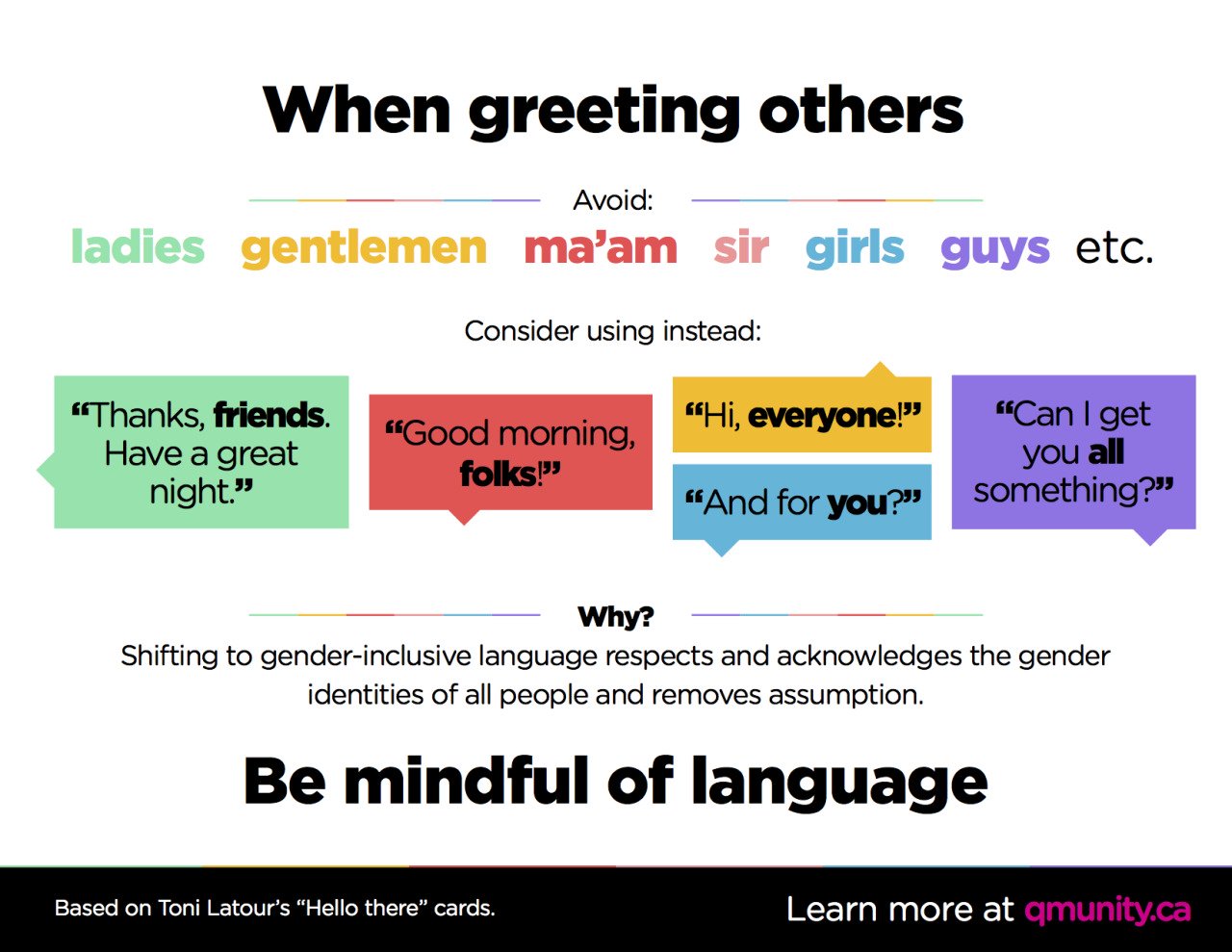
The American Philosophical Association has some great tips to eliminate the generic use of ‘he:’
• Use plural nouns
• Delete ‘he’, ‘his’, and ‘him’ altogether
• Substitute articles (‘the’, ‘a’, ‘an’) for ‘his’ and ‘who’ for ‘he’
• Substitute ‘one’, ‘we’, or ‘you’
• Minimize use of indefinite pronouns (e.g. ‘everybody’, ‘someone’)
• Use the passive voice [use sparingly]
• Substitute nouns for pronouns [use sparingly]
For more information on gender neutral job descriptions, including more lists like the one below, Textio is a great resource.

Over to you!
Language changes over time, and it’s important to continue learning and evolving. This guide is definitely imperfect, but with your help it can become more useful! What words did we miss? What definitions here don’t feel quite correct to you? Share any thoughts in the comments and I’ll do my best to keep the post up-to-date for anyone who might want to reference it.
Further reading and awesome resources
Keen to learn even more? Some of the definitions above were adapted from these sources. Plus, there’s lots more to learn at each site!
- Conscious Style Guide
- Project Include
- Progressive Style Guide
- Racial Equity Resource Guide
- Geek Feminism Wiki
Try Buffer for free
180,000+ creators, small businesses, and marketers use Buffer to grow their audiences every month.
Related Articles

We've been hosting Retreats at Buffer for 12+ years. In this article, we've detailed everything we've learned from 14 Retreats.

I recently attended my first in-person, international conference. Here's what I learned.

What it was like to join a fully remote team like Buffer, and how going on the company retreat so early on helped shape my journey in ways I hadn’t imagined.